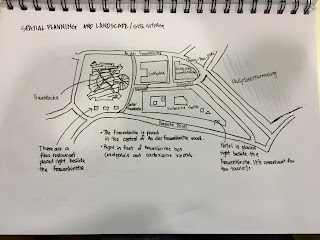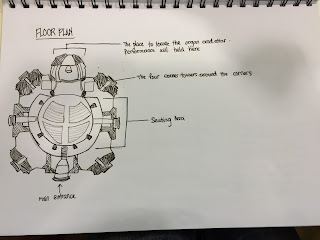This project focuses on investigating historical works to enrich architectural design and ideas. Through the study of existing buildings, students are able to communicate and expand their own architectural vocabulary and develop design concepts. In a group of 5, students are required to conduct precedent study analysis on specific building through on-line forum discussion, analysis drawings, verbal and board presentations. This precedent study analysis should help clarify the research question of “why” that specific building is historically, culturally and architecturally importance; and “how” the design concepts derived from that particular building can be developed and expanded to be creatively and innovatively integrated into their Studio 1 design project.
Learning outcome:
1. To produce building analysis which document intentions, concepts, patterns, disciplines, architectural language and contextual relationships.
2. To produce graphical development, expansion and elaboration of intentions, concepts, patterns, disciplines, architectural language and contextual relationships as integration to design project.
Part A On-line Group Forum (10% - Individual-80% and Group-20% Assessment)
On-line group forum is used in this exercise as an effective virtual learning discussion platform for students to work as a team to help each other in exploring the precedent studies of a chosen building with cultural, historical and architectural significances. Through the active on-line discussion forum, students even outside class session will be able to exchange views, share and debate the knowledge derived from the precedent studies to best grasp as well as to encourage a comprehensive analysis of the underlying conceptual ideas of the building. This on-line forum discussion will also prepare them for their verbal presentation during Studio critic session. The study of precedent required students to gather architectural information, so that they truly appreciate the essence of the building; have in-depth understanding of the building systems at work, as well as recognize the series of important elements that realize design aspects of the building.
On-line Group Forum Task: Each group is required to collectively address the questions below via TIMES WikiSpace discussion forum. As such each student in the group needs to only select just one set of questions. All discussion must be posted in TIMES Wiki Space in the form of:
a. clear and legible photographs and scanned sketches
b. short brief /write-up
5. i. What were the materials and construction technology or method used?
ii. How the materials and construction technology or method help making the building historically significant and meaningful?
https://times.taylors.edu.my/mod/wiki/view.php?pageid=4459
REFLECTION:
1. Able to put theories into practice.
2. Understand team dynamics and mobilise the power of teams.
3. Think critically and creatively
Part B. Precedent Study & Analysis Sketches Presentation (10%) and Analysis Report (10%) (Individual)
Analysis should include:
A. Answers to the Precedent Study Analysis questions below:
1. How does the building reflect the spirit of the time and place for which it was built?
2. What are the initial ideas and the design concept?
3. How the initial ideas and the design concept affecting the architecture?
B. Illustration of Precedent Study Analysis in relation to the series of building conceptual elements listed below – each student is to select and conduct analysis of one element from # 1 to 5 and to synthesize the design concept Partí of # 6.
4. Spatial Organization analysis (i. Spatial planning & Landscape/Site Siting, ii. Building sequence and process, iii. Public vs. private, iv. Axis, v. Symmetry/Asymmetry & balance, vii. Repetitive to unique, viii. Additive and subtractive, ix. Hierarchy)
6. Partí - Culminates and Summarizes (i. gesture, ii. essence, iii, dominant idea, iv salient characteristic of the building)
Reflection:
1. Locate, extract, synthesise and utilise information effectively.
2. Define and analyse problems to arrive at effective solutions.
3. Understand ethical issues in the context of the field of studies.
Part C Analysis Presentation Board (20%) (Individual)
Reflection:
1. Able to put theories into practice.
2. Manage one self and be self-reliant.














No comments:
Post a Comment